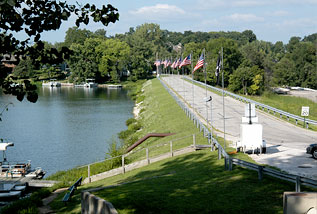Dam Owner Responsibilities
Liability and Legal Considerations
The Association of State Dam Safety Officials (ASDSO) notes in its brochure 'Dam Failure and Owner Liability' that there are approximately 10 to 20 dam failures each year in the United States. Many of these result in catastrophic impact on communities, private property, and public works downstream, including loss of life. No dam owner wants that calamity to involve his dam.
 Owner liability varies from state to state depending on statutes, regulations and case law. However, the concept of strict liability falls heavily on the dam owner for damages regardless of the cause of the failure. Georgia's dam safety law and the regulations that implement it specifically absolve the state from liability from damages caused by a dam failure.
Owner liability varies from state to state depending on statutes, regulations and case law. However, the concept of strict liability falls heavily on the dam owner for damages regardless of the cause of the failure. Georgia's dam safety law and the regulations that implement it specifically absolve the state from liability from damages caused by a dam failure.
When assessing the liability of the owner and the potential for negligence, the standard of care the dam owner should have taken will be weighed against the downstream hazards. Compliance with government regulations and professional standards, such as the responsibility of dam owners to prepare EAPs on their HHP dams, establishes a minimum standard of care to be followed by the owners.
Learn Owner Liability
ASDSO notes that to manage risks and control potential loss an owner will need to provide employee training, regular maintenance, emergency preparedness, and liability insurance. Each HHP dam should have:
- A state dam safety permit.
- An operation plan, documented regular maintenance plan, and Emergency Action Plan.
- Documented periodic inspections.
- Warning signs and controlled access.
The Owner, Not the State, is Liable
Laws pertaining to Georgia's Safe Dams Program are embodied in the "Georgia Safe Dams Act of 1978", (O.C.G.A. 12-5-370 through 12-5-385) last amended in 1990.
Dam owners should note paragraph 12-5-383 Liability for Damages:
No action shall be brought against the state, the board, the division, or any member, officer, or employee of the state, the board, or the division for damages sustained through the partial or total failure of any dam or other artificial barrier dealt with in this part or its maintenance by reason of any supervision or other action taken or not taken pursuant to or under this part ... Nothing in this part and no order, action, or advice of the director or the division or any representative thereof shall be construed to relieve a dam owner or operator of the legal duties, obligations, or liabilities incident to the ownership or operation of the dam.
Laws governing the Georgia Safe Dams Rules are found in Chapter 391-3-8 of the Rules of the Department of Natural Resources Environmental Protection Division, last amended in 1998. Section 391-3-8-.10 notes:
Inspection and Maintenance Plan Requirements. Dam owners and operators of dams shall be responsible for conducting routine inspection and maintenance of dams necessary to:
- Prevent the growth of trees or brush on the embankment of the dam and on the spillway system;
- Prevent the accumulation of debris, obstructions, or other deleterious materials from the spillway system;
- Insure that all gates, orifices, dissipators, trash racks, and other appurtenances that affect the proper operation of the dam and reservoir are kept in good repair and working order, and that spillway and outlet gates necessary to pass flood flows shall be test operated at least once each year. The dam owner shall file an affidavit with the Director certifying that such appurtenances and gates are in good working order;
- Maintain adequate and suitable vegetation to prevent erosion of the embankment and earth spillway for the dam;
- Determine that any seepage on the downstream slopes of the dam does not exceed normal amounts and does not present a situation indicative of potential dam failure. At any time where there is a questions regarding seepage and potential dam failure, the Director shall be notified in writing and provided a description of the situation, and
- Dam owners shall immediately notify the Division when symptoms of failure, including but not limited to, erosion, surface cracks, seepage, settlement, or movement occur.
